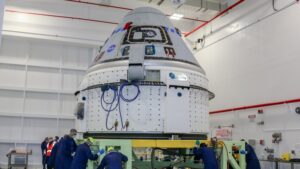That review made 80 recommendations involving testing, software development, communications and other issues.
That mission was cut short, and a planned docking with the International Space Station canceled, because of software problems. An additional software problem, found and corrected in flight, could have damaged the spacecraft as it separated its service module just before reentry.
“Closing all of the Independent Review Team findings for the software and communications systems is a huge milestone for the Commercial Crew Program and included many long hours of testing and reviews by our dedicated Boeing and NASA teams during this COVID-19 pandemic,” Steve Stich, manager of NASA’s commercial crew program, said in an agency statement.
NASA confirmed that the second uncrewed test flight of Starliner, called OFT-2, remains on schedule for launch on an Atlas 5 July 30 from Cape Canaveral Space Force Station in Florida. That mission will carry out the tasks planned for the initial flight, including a space station docking, and spend 5 to 10 days in orbit before landing in the western United States.
The launch date appeared to be in question earlier this month because of delays with another mission launching on an Atlas 5. United Launch Alliance said June 4 that it was delaying the Space Test Program (STP) 3 mission, which had been scheduled to launch June 23. The company said the delay was required to “evaluate launch vehicle readiness.”
That initially raised concerns of a domino effect, with the delay of the STP-3 mission pushing back the Starliner launch. Tory Bruno, president and chief executive of United Launch Alliance, tweeted that the STP-3 delay was to investigate vibrations, or “ringing,” seen in a new nozzle extension on the RL10 engine that powers the Centaur upper stage. “We want to make sure we fully understand that behavior before flying this configuration again,” he wrote.
However, the Centaur that will be used for the Starliner mission does not use that same nozzle extension. ULA tweeted June 10 that it was beginning preparations for the Starliner launch, calling it “our next Atlas 5 launch” and scheduled for July 30, the date previously announced by NASA and Boeing for the mission.
NASA said that, if the OFT-2 mission launched on schedule and is successful, it is considering flying the first crewed flight of Starliner, the Crew Flight Test mission, this year. That will transport NASA astronauts Butch Wilmore, Nicole Mann and Mike Fincke to the station. NASA said in the statement that the agency and Boeing “will look for opportunities toward the end of this year” to fly the mission.



